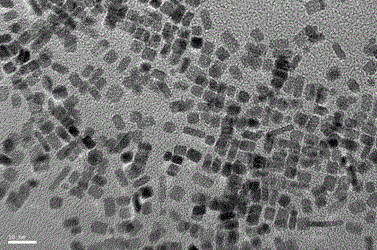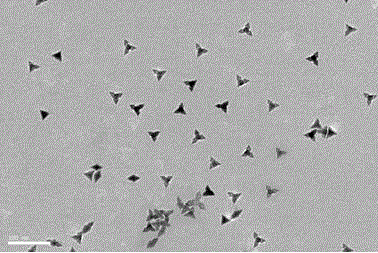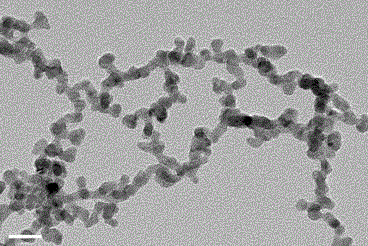A method for the controllable synthesis of noble metal nanocatalysts using amino acids as soft templates
A nano-catalyst and amino acid technology, which is applied in the direction of nanotechnology, can solve the problems of toxic substances, unfavorable green and environmental protection synthesis concepts, etc., and achieve high reproducibility, good dispersion and stability, and simple preparation methods.
- Summary
- Abstract
- Description
- Claims
- Application Information
AI Technical Summary
Problems solved by technology
Method used
Image
Examples
Embodiment 1
[0034] A method for controllable synthesis of noble metal nano-catalysts using amino acids as soft templates includes the following steps:
[0035] (1) Pipette 0.5 ml 0.5 M lysine solution and 1.0 ml 0.05 M K 2 PtCl 4 The solution was added to 8 ml of deionized water and mixed with ultrasound to form uniform lysine-K 2 PtCl 4 Complex solution
[0036] (2) Add Lysine-K under stirring 2 PtCl 4 Add 50 mg of polyvinylpyrrolidone (PVP) to the complex solution and adjust the pH of the mixed solution to 9.0;
[0037] (3) Add 0.5 ml of HCHO (40%wt) solution to the mixed solution of step (2), and then put it into a hydrothermal reactor; place the reactor in a dry box at 160°C for 4 hours;
[0038] (4) After centrifugal separation, washing, and vacuum drying of the obtained black suspended matter, the Pt nanoparticles with controllable synthesis of lysine are obtained.
[0039] Observe the TEM of the Pt nanoparticles prepared above, as attached figure 1 As shown, the Pt nanoparticles have a hexa...
Embodiment 2
[0041] A method for controllable synthesis of noble metal nano-catalysts using amino acids as soft templates includes the following steps:
[0042] (1) Pipette 0.4 ml 0.5 M arginine solution and 0.5 ml 0.05 M PdCl 2 The solution was added to 8 ml of deionized water and mixed with ultrasound to form uniform arginine-PdCl 2 Complex solution
[0043] (2) Under agitation to arginine-PdCl 2 Add 50 mg of polyvinylpyrrolidone (PVP) to the complex solution and adjust the pH of the mixed solution to 12.0;
[0044] (3) Add 0.5 ml of HCHO (40%) solution to the mixed solution of step (2), and then put it into a hydrothermal reactor; place the reactor in a dry box at 140°C for 4 hours;
[0045] (4) After centrifugal separation, washing, and vacuum drying of the obtained black suspended matter, the Pd nanoparticles with controllable synthesis of arginine are obtained.
[0046] Observe the TEM of the Pd nanoparticles prepared above, as attached figure 2 As shown, the Pd nanoparticles have a uniformly...
Embodiment 3
[0048] A method for controllable synthesis of noble metal nano-catalysts using amino acids as soft templates includes the following steps:
[0049] (1) Pipette 0.4 ml 0.5 M lysine solution and 0.5 ml 0.05 M PdCl 2 The solution was added to 8 ml of deionized water and mixed with ultrasound to form uniform lysine-PdCl 2 Complex solution
[0050] (2) Add Lysine-PdCl under stirring 2 Add 50 mg of polyvinylpyrrolidone (PVP) to the complex solution and adjust the pH of the mixed solution to 12.0;
[0051] (3) Then put the mixed solution of step (2) into a hydrothermal reaction kettle (note: there is no HCHO in this example), and place it in a drying box at 140°C for 2 h;
[0052] (4) After centrifugal separation, washing, and vacuum drying of the obtained black suspended matter, the Pd nanoparticles with controllable synthesis of lysine are obtained.
[0053] Observe the TEM image of the Pd nanoparticles prepared above, as attached image 3 As shown, the Pd nanoparticles have a chain morpholo...
PUM
 Login to View More
Login to View More Abstract
Description
Claims
Application Information
 Login to View More
Login to View More - R&D Engineer
- R&D Manager
- IP Professional
- Industry Leading Data Capabilities
- Powerful AI technology
- Patent DNA Extraction
Browse by: Latest US Patents, China's latest patents, Technical Efficacy Thesaurus, Application Domain, Technology Topic, Popular Technical Reports.
© 2024 PatSnap. All rights reserved.Legal|Privacy policy|Modern Slavery Act Transparency Statement|Sitemap|About US| Contact US: help@patsnap.com










